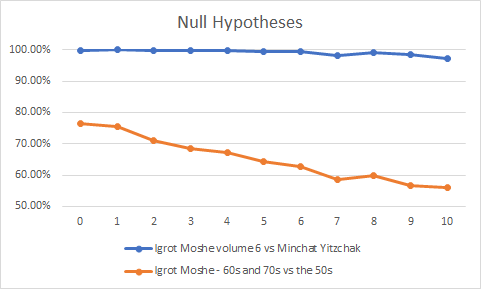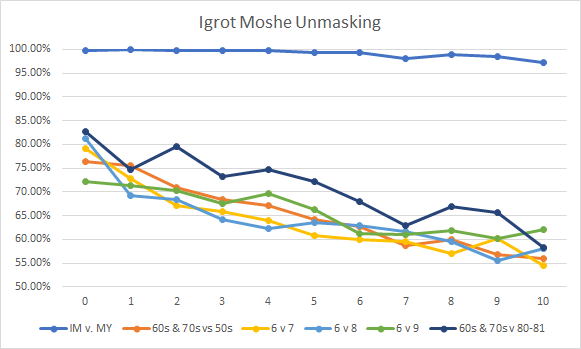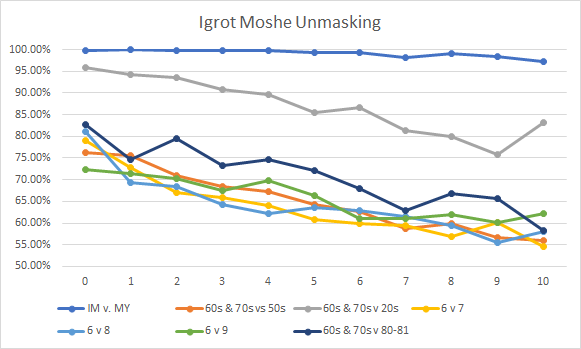Who Wrote the Late Volumes of Igrot Moshe?
By: Moshe Schorr[1]
Moshe Schorr is a Computer Science student at the Technion, Research Assistant at University of Haifa, graduate of Yeshivat Har Etzion, and cofounder of HaMapah.
HaMapah aims to bring modern tools of quantitative analysis and geographic information systems to Rabbinic literature. The visual representations of the data we harvest show spheres of influence through time and across space. They have already yielded numerous insights and surprises about the shape of rabbis’ network of correspondence and the trajectory of their careers. These phenomena, which have never been noticed before, raise a host of new questions, large and small, for a new generation of scholars and historians to consider. Follow HaMapah via Facebook and get updates via WhatsApp.
Though this article deals with a factual question, it often seems to devolve into an ideological one. I therefore wish to state: I have no horse in this fight. I have not taken halakhic positions from Igrot Moshe volumes 7-9. I went into this with a genuinely open mind, and in the course of researching this question, I have taken the affirmative and negative sides of this question at different points.
Ever since Igrot Moshe volume 8 was published, and to a lesser degree volume 7, people have cast aspersions or directly accused it of being a forgery. The claim, generally, has been some variation of direct accusation or insinuation that somebody, usually either one of the Tendlers or R. Shabtai Rappaport, inserted his own teshuvot into the volume. Volume 9 is, as they say, ‘right out’. Some even call these volumes ‘Igrot Moshe David’.
As an example, Hirhurim several years ago published this quote from R. J.D. Bleich, though the comment thread is likely a better example.
Given the overwhelming consensus among latter-day authorities affirming the prohibition against drinking wine touched by a Sabbath-violator, Iggerot Moshe‘s position is surprising, to say the least. Moreover, the thesis developed in that responsum stands in sharp contradiction to Iggerot Moshe‘s earlier-cited multiple statements affirming the prohibition. Perplexed by Rabbi Feinstein’s surprising volte face, Rabbi Genut turned to a long-time, but unnamed, disciple of Rabbi Feinstein for clarification. Rabbi Genut quotes the disciple’s reply in which the latter writes that “it is known to me that many of the responsa [included in the posthumously-published eighth volume of Iggerot Moshe] were not before the eyes of my master and teacher… and there is also doubt with regard to many responsa in the seventh volume.”
The counterclaim, presented by the editors in the introduction to volume 8, is that the editors did exactly what their job entails: editing. While they added references, the teshuvot are by R. Moshe Feinstein.
I decided to test this. So the first thing I did was use an dataset given to me by Michael Pitkowsky, giving the dates, by year, of each teshuvah in volumes 1-8 of Igrot Moshe. This immediately yielded a stark result.
The spike in output in 1980-1981 is shocking. It is reminiscent of Barry Bonds’ late career.[2] It looks like a steroid year spike -- how does a man in his eighties suddenly have more productivity than ever before? This, the first thing I saw, made me extremely suspicious. For comparison, Hatam Sofer’s chart looks like this:
I have published more on this at HaMapah, but suffice it to say: we expect to see a good deal of statistical noise in the amount of output,[3] though we do not expect to see changes that drastic, certainly not massive increases from authors in failing health.
This gave me the impetus to take the analysis a step further. So Avi Shmidman and I applied authorship analysis to it.[4]
Let me give a brief explanation of the algorithm. We are trying to look at the differentiability of the two classes. So, we take the 250 most common words, and then we look at the ability of a fairly standard model to separate the two classes. We expect to see some flukes or minor differences, so we’ll remove the most useful features -- the words that are most predictive, and re-run. We will repeat this process ten times, removing three words each time. Different authors will have very substantially different linguistic usage -- how often do you use the word ‘הוא’, ‘אבל’, etc., so even after removing the 30 most predictive words out of the 250 we’ll start with, it’ll be easily differentiated. However, with the same author, by this point the flukes should be gone, and we’ll lose any meaningful ability to differentiate the two classes. After the ten rounds we will be barely better than random guessing. (You’ll see at one point 58% accuracy -- don’t be impressed -- coin tossing is 50% accurate.)
Let’s start with our null hypothesis. Nobody, as far as I am aware, believes that the authors of Igrot Moshe and Minhat Yitzchak were one and the same. When running them against each other (IM vol. 6 vs Minhat Yitzchak), we get a final round accuracy of 97%. As we would expect. Now if we look at Igrot Moshe until we get to our “steroid spike”, if we compare the 60s and 70s to the 50s, we can get a sort of parallel null hypothesis.
So then we can just turn to our suspicious sets, and see where they fall.
Igrot Moshe volume 6, being the most recent undisputed volume, is the natural choice to benchmark here in terms of volumes. So let’s look at the three disputed volumes against volume six, and for good measure, let’s look at our “steroid spike” in 1980-1981 against the 60s and 70s.
The results are pretty clear. Bupkis. Nada. Zilch. None of the potential ways to slice and dice any of the potential forgeries turn up anything at all. And for the icing on the cake, most people who’ve learned Igrot Moshe would probably tell you that his prewar stuff is pretty different. Let’s compare the 20s against the 60s & 70s (the gray line).
So we see that not only are the differences between the new volumes and volume six minimal to the point of nonexistence, they’re far less differentiable than parts of his own corpus which are otherwise not under any suspicion are.
Let’s look at one last thing. Let’s look at our top ten features in favor of volume 9 over volume 6 when we tell them apart:
- ע"א
- ע"ב
- ולכן
- תמה
- רש"י
- בעניין
- לו
- התוספות
- חייב
- ד"ה
We generally consider ע”א, ע”ב, ד”ה -- markers 1, 2, and 10 -- to be markers of a good editor, and people pay good money for the expanded references in Mossad HaRav Kook editions. Numbers 5 and 8 are also components of references, as is 4, generally. So I’d like to suggest the following: the late volumes of Igrot Moshe bear substantial marks of editing. Having seen those, and generally getting a whiff of a difference, people justifiably viewed the late volumes of Igrot Moshe as tampered with, as fake even, with good reason, despite it just being editing. This isn’t without precedent. The common reyd, that the Terumat HaDeshen made up his own questions, has been disproven.[5] It seems to be from a similar reason - ‘good’ editing (as it was then considered) - stripping ‘unnecessary’ detail from the questions. So too here. The editor’s changes might be more immediately visible, but the consistent usage of simple function words - how often do you use function words like אני, הוא, זה, etc. -- belies the true nature of the author.
Given the preponderance of evidence that the later Igrot Moshe volumes are real (and spectacular), I think we can put the various theories of alternative authorship to rest. The claims of the editors -- that the latest teshuvot were dictated[6] -- explains the ‘steroid spike’, and all available evidence supports their central contention, that they didn’t change the actual content. In short: it’s legit.
[1] Software by Avi and Shaltiel Shmidman. Data from Michael Pitkowsky. Algorithm as described in Koppel et al. (see below, footnote 4). With thanks to Elli Fischer.
[2] *
[3] To clarify: I’m not saying it didn’t happen, just it’ll fluctuate a lot without an actual cause or real reason.
[4] Koppel, Schler, Bonchek-Dokow: “Measuring Differentiability: Unmasking Pseudonymous Authors,” Journal of Machine Learning Research 8 (2007) 1261-1276.
[5] J. Freiman, Leket Yosher, Berlin ed. p. XIV. http://hebrewbooks.org/pdfpager.aspx?req=8860&st=&pgnum=10
[6] See volume 8, p. 3 in the introduction.




